call 908.362.9981 and speak with a filtration specialist for immediate assistance
There are many different styles of bag filter housings to choose from and
this article will help you determine which is the best fit for your application.
Simplex bag filter vessels require the flow rate to be interrupted or diverted to safely access the filter bag chamber(s).
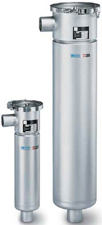 Eaton
Ecoline filter housing:
Used for "light duty" applications and rated for a maximum pressure
of only 100 PSI, the Ecoline has a clamp style closure and is only
available in 316SS material with FNPT threaded connections. It does
have some notable features, such as an investment cast concave
chamber cover which displaces some fluid so that when the chamber is
opened the fluid level is below the edge of the vessel. We can
modify the vessel to have differential pressure ports, but that is
about as much "customization" this design offers. The Ecoline
cannot be ASME code stamped and filter bag sealing is assisted by a
separate internal spool which transfers the downward pressure of the
lid closure across the circumference of the filter bag. This
type of sealing is characteristic of all our housing designs EXCEPT
the Topline
and therefore applications requiring high efficiency particle
retention (greater than 65%) and especially for particle retention
<50 microns, the Topline design should be utilized.
Eaton
Ecoline filter housing:
Used for "light duty" applications and rated for a maximum pressure
of only 100 PSI, the Ecoline has a clamp style closure and is only
available in 316SS material with FNPT threaded connections. It does
have some notable features, such as an investment cast concave
chamber cover which displaces some fluid so that when the chamber is
opened the fluid level is below the edge of the vessel. We can
modify the vessel to have differential pressure ports, but that is
about as much "customization" this design offers. The Ecoline
cannot be ASME code stamped and filter bag sealing is assisted by a
separate internal spool which transfers the downward pressure of the
lid closure across the circumference of the filter bag. This
type of sealing is characteristic of all our housing designs EXCEPT
the Topline
and therefore applications requiring high efficiency particle
retention (greater than 65%) and especially for particle retention
<50 microns, the Topline design should be utilized.
Eaton Miniline Filter Housing: A version of the Ecoline above designed to be used with smaller size filter bags (#3 and #4 sizes). Reserved for low flow rate applications when a compact size/footprint is desired, they are not much different in cost from the "full size" (#1 and #2 size) Ecoline and Flowline II bag filter housings.
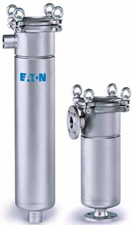 Eaton
Flowline II Filter Housing: This is an inexpensive version of the
Flowline
housing design, having some additional material options compared to
the Ecoline (carbon steel, 304SS and 316SS), Flowline II vessels are
rated to 150 PSI due to its swing bolt closure and are offered with
flanged or threaded connections. Their body is hydro formed,
reducing the number of weld areas, promoting a smoother internal
finish. While the manufacturing process reduces the cost of
the Flowline II, it also means that customizations such as adding
differential pressure taps, surface polishing and non-standard
connections are not available. As with the Ecoline above, this
entry-level housing is designed for nominally rated filter bag
applications where an ASME code stamp is not required.
Eaton
Flowline II Filter Housing: This is an inexpensive version of the
Flowline
housing design, having some additional material options compared to
the Ecoline (carbon steel, 304SS and 316SS), Flowline II vessels are
rated to 150 PSI due to its swing bolt closure and are offered with
flanged or threaded connections. Their body is hydro formed,
reducing the number of weld areas, promoting a smoother internal
finish. While the manufacturing process reduces the cost of
the Flowline II, it also means that customizations such as adding
differential pressure taps, surface polishing and non-standard
connections are not available. As with the Ecoline above, this
entry-level housing is designed for nominally rated filter bag
applications where an ASME code stamp is not required.
Eaton Flowline Filter Housing: This is the entry-level housing for industrial applications that do not require an ASME code stamp. Since the manufacturing technique involves additional welding, its more expensive than the Flowline II but it also enables non-standard connection types, differential pressure taps and surface polishing.
Eaton Sideline Filter Housing: These filter bag housings can be customized more than the above, to include features such as steam jacketing, side outlet location and can be ASME UM or U stamped; CRN registration is also supported with this design. Features such as a concave displacement cover and a hold down spool are standard and similar to the other designs mentioned above.
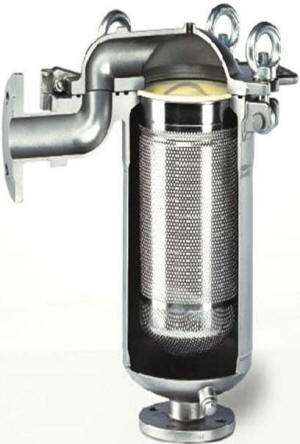 Eaton
Topline Filter Housing: Featuring a "goose neck" or "over-the-top"
inlet design, the Topline style housing represents the best sealing
capability of all bag filter housing designs. This is because
a hold-down spool is not required to seal the filter bag to the
vessel, rather the chamber cover directly interfaces with the bag
sealing ring and forms a bypass-free seal. This type of direct
seal with the filter bag is only possible with this inlet
configuration as it enables the filter bag to be placed at the top
rim of the vessel. The additional complexity of this
design contributes to its higher cost, but for applications
requiring efficient retention of particles smaller than 50 microns,
it is the best design to use. This ASME code
stamped vessel can be polished internally or externally as well as customized with
special connections, a steam jacket or differential pressure
connections.
Eaton
Topline Filter Housing: Featuring a "goose neck" or "over-the-top"
inlet design, the Topline style housing represents the best sealing
capability of all bag filter housing designs. This is because
a hold-down spool is not required to seal the filter bag to the
vessel, rather the chamber cover directly interfaces with the bag
sealing ring and forms a bypass-free seal. This type of direct
seal with the filter bag is only possible with this inlet
configuration as it enables the filter bag to be placed at the top
rim of the vessel. The additional complexity of this
design contributes to its higher cost, but for applications
requiring efficient retention of particles smaller than 50 microns,
it is the best design to use. This ASME code
stamped vessel can be polished internally or externally as well as customized with
special connections, a steam jacket or differential pressure
connections.
Eaton Polyline Filter Housing and Hayward FLV Filer Housing: Represent our non-alloy designs (PVC, CPVC and PVDF). These are typically used for non-alloy pipelines and thus have some limitations; they cannot be ASME code stamped, polished or steam jacketed and their flow rates are typically limited to a maximum of 100 GPM. These are more expensive than their alloy counterparts and chosen for aggressive chemistries which otherwise would require expensive, "exotic" alloys.
All of the bag filter vessels above are single chamber, simplex designs. Therefore the flow rate is limited to the capacity of the single filter bag used within it and the process needs to be interrupted to change-out the filter bag.
To accommodate flow rates above 180 GPM, using specialty filter bags having a reduced flow capacity or for viscous fluids, using multiple chambers (filter bags) simultaneously is required.
MULTIPLE CHAMBER DESIGNS
 Eaton
Douline Filter Housing: Consist of two bag filter housings connected
by a common inlet and outlet manifold and thus having double the
capacity of a single chamber design; there are no valves to divert
flow, flow passes through both chambers simultaneously.
Eaton
Douline Filter Housing: Consist of two bag filter housings connected
by a common inlet and outlet manifold and thus having double the
capacity of a single chamber design; there are no valves to divert
flow, flow passes through both chambers simultaneously.
Within the 3, 4, 6 and 8 chamber range there are several design options
offered.
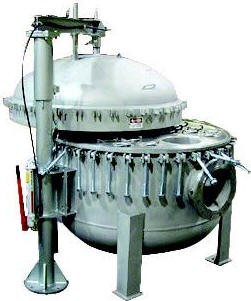
This
MBFH is generally the least expensive design, available in a wide range of
materials and is the only option for 10+ chamber models. Some
Manufacturers offer the outlet nozzle welded tangentially to the
bottom dish as compared to using an elbow at the bottom of the dish
and this significantly reduces the height of the MBFH assembly.
This reduction in height often eliminates a requirement for ladders
and scaffolding around the housing and it is actually safer to be
located firmly on the ground without having to strain for filter bag
access.

Counter weighted spring assisted hinged covers can be opened and closed
safely by a single individual. This fantastic feature costs about 10% more
when compared to the lifting davit style, justified with its reduced footprint
and improved ergonomics.
While swing bolts provide relatively quick access to the filter vessel,
access is further improved with a gear operated clamp closure which ensures
positive and equal sealing across the chamber cover sealing area.

ECONOMY MODELS

Eaton MAXILINE Filter Housing and Eaton PROLINE Filter Housing vessels have the same basic features and flow capacity. However, the PROLINE is only available in 304L SS and is not available with an ASME code stamp. If your application is compatible with less expensive carbon steel material or requires 316L SS (or other customizations with or without an ASME code stamp), then the MAXILINE design is the way to go.
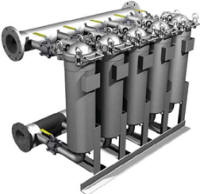
Another way to approach high flow rate filtration applications is using several standard single filter bag vessels connected to a common inlet and outlet/drain manifold. An advantage of this approach is that, when properly sized, individual housings can be isolated and filter bags replaced without needing to shut down or “duplex” the system and thus can significantly reduce initial costs.
The filter housings can be oriented on both sides of an inlet/outlet header to
shorten its length and if you extend these headers, it will enable adding
additional filter stations in the future.
DUPLEXED FILTER HOUSINGS
When your process cannot be interrupted to change filter bags and you are not using the Moduline configuration above, we can supply a pair of simplex housings connected by a common manifold having diverting valves to isolate the chamber to be serviced.
Flow Rate (chamber size and number of chambers required)
The size of the bag filter vessel (number of filter bag chambers) depends upon the diameter and length of the filter bags required for your specific application. The four "industry standard" filter bag sizes are referred to as being #1, #2, #3 or #4 sizes, with #1 and #2 sizes being the most common for industrial applications.
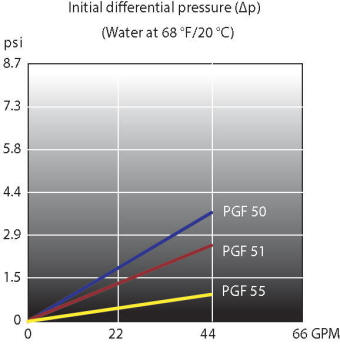
When you complete our inquiry form
or otherwise contact us by email or phone, our filtration experts will
gather information about the filter bag aspect of your application to ensure
the most appropriate bag filter housing is suggested. Our filter bag website
provides detailed information and specification sheets for a variety of
filter bag types, complementing our filter bag housing website.







